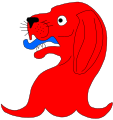Erasure (heraldry)
Erasure in blazon, the language of heraldry, is the tearing off of part of a charge, leaving a jagged edge of it remaining. In blazons the term is most often found in its adjectival form, erased, and is usually applied to animate charges, most often heads or other body parts.[1]
.svg.png)
langued azure
The term erased is most often used of an animal's head, when the neck is depicted with a ragged edge as if forcibly torn from the body. Erased heads are distinct from those couped, in that the first are left with a jagged edge, while the second have a straight edge, as if cut with a sword.[2]
John Craig's dictionary of 1854 says:
In Heraldry, anything is said to be erased which appears forcibly torn off, leaving the edges jagged and uneven.[3]
When a tree or other plant is shown uprooted, with the bare roots showing, it is called eradicated.[1]
Forms of erasure
.svg.png)
There are different traditions for the erasing of heads. For instance, with the head of a bear, whether couped or erased, in English heraldry the separation is done horizontally under the neck, which is not lost, whereas in Scottish heraldry the usual practice is for the head to be separated from the body vertically, without keeping the neck attached to it.[4]
Gallery
 Talbot’s head erased gules langued azure
Talbot’s head erased gules langued azure Boar's head erased argent langued gules tusked or
Boar's head erased argent langued gules tusked or.svg.png) Griffin's head erased
Griffin's head erased Cow’s head erased proper
Cow’s head erased proper.svg.png) Stag's head erased
Stag's head erased Fox’s head erased or langued gules
Fox’s head erased or langued gules
See also
References
- James Parker, A Glossary of Terms Used in Heraldry (1894; new edition by James Parker and Company, Oxford, 2004)
- Thomas Woodcock, John Martin Robinson, The Oxford Guide to Heraldry (Oxford: Oxford University Press, 1988, ISBN 0-19-211658-4), p. 200
- John Craig', A new universal, technological, etymological, and pronouncing dictionary of the English language (vol. 1, 1854), p. 656
- Charles Boutell, Heraldry (F. Warne, 1950), p. 71